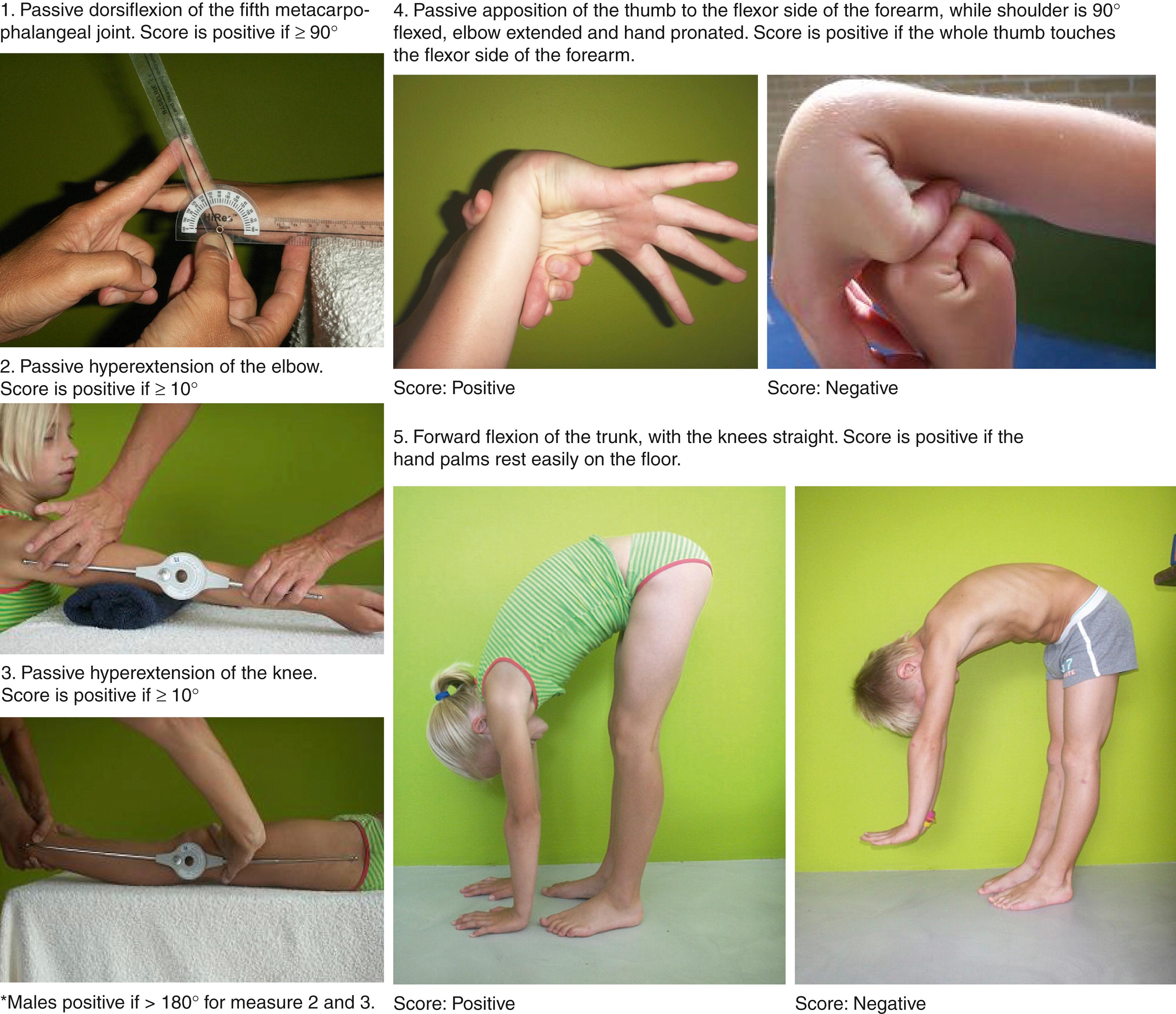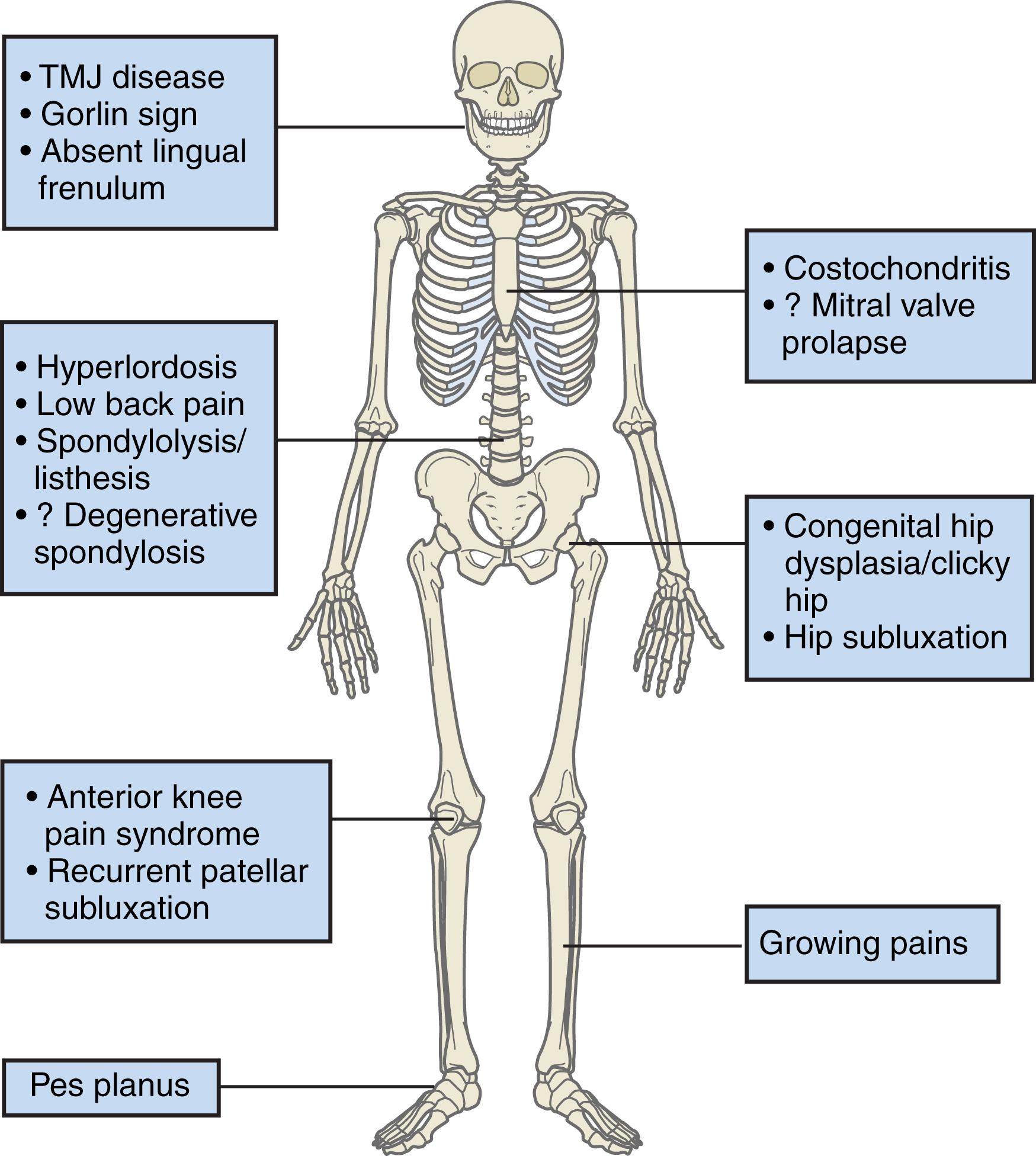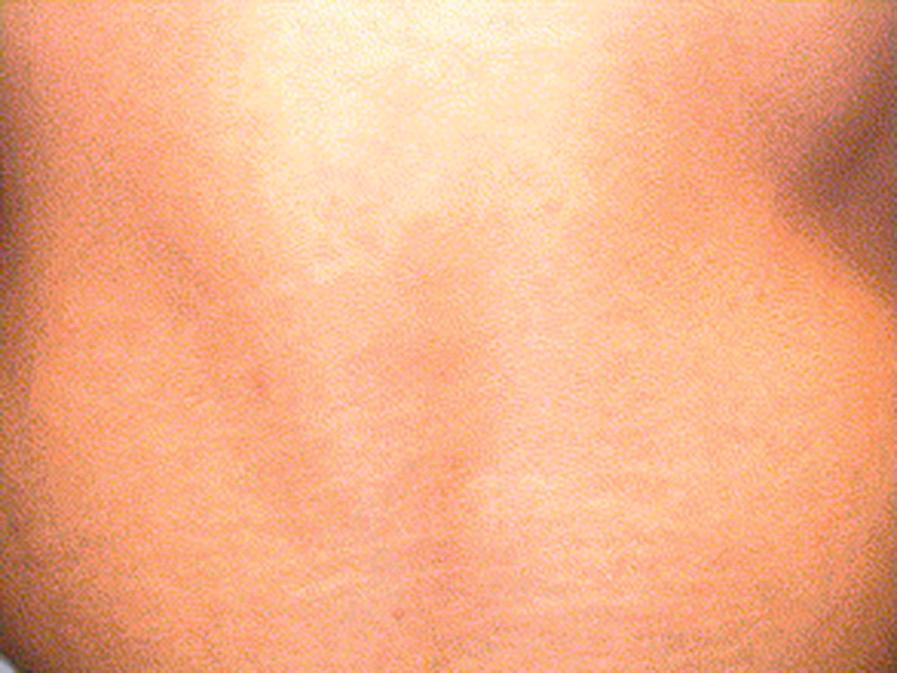Physical Address
304 North Cardinal St.
Dorchester Center, MA 02124
It is estimated that up to 25% of the population reports the presence of joint hypermobility, but a quarter of the population does not have an associated connective tissue disorder, nor is the increased mobility deemed a health concern; nonetheless, hypermobility may be associated with a connective tissue disorder. In addition, there is a vast spectrum of comorbidities attributed to the presence of hypermobility ( Fig. 47.1 and Table 47.1 ).
| System | Symptom/Sign |
|---|---|
| Integument | Striae (see Fig. 47.4 ) |
| Easy and frequent bruising | |
| Skin hyperextensibility (see Fig. 47.5 ) | |
| Poor wound healing, easy scarring (see Fig. 47.6 ) | |
| Cardiovascular | Dizzy spells |
| Postural orthostatic tachycardia or orthostatic intolerance | |
| Palpitations | |
| Musculoskeletal | Joint instability/frequent ankle sprains/subluxations (knee, shoulder)/congenital hip dislocation |
| Temporomandibular joint pain | |
| Scoliosis | |
| Chronic fatigue; exercise intolerance | |
| Pes planus | |
| Genu recurvatum | |
| Chronic musculoskeletal pain syndromes (focal or generalized) | |
| Neurologic | Headache (orthostatic; intracranial hypotension) |
| Anxiety | |
| Sleep disturbance | |
| Fibromyalgia | |
| Restless leg syndrome | |
| Chiari type I | |
| Delayed locomotor development | |
| Poor handwriting | |
| Cerebrospinal fluid leaks | |
| Gastrointestinal | Irritable bowel syndrome (bloating, pain) |
| Constipation/gastroparesis | |
| Abdominal migraine | |
| Nausea/cyclic vomiting | |
| Rectal prolapse | |
| Hernias | |
| Absent lingual frenulum | |
| Urogenital | Uterine prolapse |
| Cervical incompetence | |
| Frequency; stress incontinence | |
| Vulvodynia |
There have been several methodologies used to accurately define the presence of joint hypermobility; the most universally accepted method is the Beighton score ( Fig. 47.2 and Tables 47.2 and 47.3 ). Possible reasons for the estimated high incidence of hypermobility in the general population is the incorrect application of the criteria listed in the Beighton score or not applying the relevant age-appropriate adjustment to the score (see Table 47.3 ). It is important to strictly adhere to the guide in Fig. 47.2 and to use a goniometer to ensure accurate measurement of joint angles. Patients tend to overestimate their own hypermobility; one should avoid unnecessary diagnostic evaluations that might not add value to the purpose of assessing the underlying etiology of the presenting symptoms. The Beighton score has typically been reserved for children older than 6 years of age because it may be unreliable in younger children who have a propensity for natural joint hypermobility. One revision of the Beighton score that includes ankle dorsiflexion has been reported as a reliable indicator for children up to the age of 5 years.

| Description | Bilateral Testing | Scoring (Max. Points) |
|---|---|---|
| Passive dorsiflexion of the fifth metacarpophalangeal joint to ≥90 degrees | Yes | 2 |
| Passive hyperextension of the elbow >190 degrees in females and >180 degrees in males | Yes | 2 |
| Passive hyperextension of the knee >190 degrees in females and >180 degrees in males | Yes | 2 |
| Passive apposition of the thumb to the flexor side of the forearm while the shoulder is flexed 90 degrees, elbow is extended, and hand is pronated | Yes | 2 |
| Forward flexion of the trunk, with the knees straight, so that the hand palms rest easily on the floor | No | 1 |
| Total | 9 |
| Age range | < Puberty | Puberty–50 yr | >50 yr | Any age with joint injury |
| Positive Beighton Score | ≥6 | ≥5 | ≥4 | Age score – 1 |
The structural integrity of connective tissues ensures normal articular surfaces, normal bone structure and strength, normal tendon insertion, and both macroscopic and microscopic support for muscles. The range of disorders involving primary connective tissue integrity extends from bone dysplasia, muscle dystrophy, and myopathy to the more well-recognized hereditary disorders of connective tissue such as Ehlers-Danlos syndrome ( Table 47.4 ). Hypermobility is also a common feature seen in chromosomal aneuploidies and neurodevelopmental syndromes such as Down syndrome. A review of a commonly used database for matching phenotypes with syndromic traits identified >500 entries spanning these broad groups within the differential diagnostic consideration for hypermobility ( Table 47.5 ).
| Type | Gene | Skin Findings | Joint Changes | Inheritance | Other Comments |
|---|---|---|---|---|---|
| Classic | COL5A1, COL5A2 (usually haploinsufficiency) | Hyperextensibility, bruising, velvety skin, widened atrophic scars, molluscoid pseudotumors, spheroids | Hypermobility and its complications, joint dislocations | AD | Mitral valve prolapse, hernias |
| COL1A1- specific pathogenic variant c934C>T | AD | Blue sclerae, short stature, osteopenia/fractures; may have late arterial rupture | |||
| Classic Variants | |||||
| Cardiac valvular | Biallelic loss of function for COL1A2 | Classic EDS features | AR | Severe cardiac valve issues as adult | |
| Periodontal | C1R C1S |
Can have classic EDS features | Can have hypermobility | AD | Periodontitis, marfanoid habitus, prominent eyes, short philtrum |
| Classic-like | TNXB | Hyperextensibility, marked hypermobility, severe bruising, velvety skin, no scarring tendency | Hypermobility | AR | Parents (especially mothers) with one TNXB gene variant; can have joint hypermobility |
| Hypermobility | Unknown | Mild hyperextensibility, scarring textural change | Hyperextensibility, chronic joint pain, recurrent dislocations | AD | Sometimes confused with joint hypermobility syndrome |
| Vascular | COL3A1 Rare variants in COL1A1 | Thin, translucent skin, bruising, early varicosities, acrogeria | Small joint hypermobility | AD | Abnormal type III collagen secretion; rupture of bowel, uterus, arteries; typical facies; pneumothorax |
| Kyphoscoliosis | PLOD (deficient lysyl hydroxylase) FKBP14 |
Soft, hyperextensible skin; bruising; atrophic scars | Hypermobility | AR | Severe congenital muscle hypotonia that improves a little in childhood, congenital kyphoscolioses, scleral fragility and rupture, marfanoid habitus, osteopenia, sensorineural hearing loss |
| Variants with Kyphoscoliosis | |||||
| Spondylocheirodysplastic form | SLC39A13, which encodes the ZIP 13 zinc transporter β4GALT7 or β3GaIT6, encoding galactosyltransferase I or II, key enzymes in GAG synthesis | Similar to kyphoscoliotic form | AR | Spondyloepimetaphyseal dysplasia; can have bone fragility and severe progressive kyphoscoliosis without congenital hypotonia, moderate short stature, loose facial skin, wrinkled palms with thenar and hypothenar atrophy, blue sclerae, curly hair, alopecia | |
| Brittle cornea syndrome | ZNF469 or PRDM5 | Skin hyperextensibility | Joint hypermobility | AR | Kyphoscoliosis; characteristic thin, brittle cornea; ocular fragility; blue sclera; keratoconus |
| Musculocontractural | CHST14 (encoding dermatan 4-O-sulfotransferase) DSE (encoding dermatan sulfate epimerase) |
Fragile, hyperextensible skin with atrophic scars and delayed wound healing | Hypermobility | AR | Progressive kyphoscoliosis, adducted thumbs in infancy, clubfoot, arachnodactyly, contractures, characteristic facial features, hemorrhagic diathesis |
| Myopathic | COL12A1 | Soft, hyperextensible | Hypermobile small joints, large joint contractures (hip, knees, elbows) | AD or AR | Characterized by muscle hypotonia and weakness |
| Arthrochalasis | Exon 6 deletion of COL1A1 or COL1A2 | Hyperextensible, soft skin with or without abnormal scarring | Marked hypermobility with recurrent subluxations | AD | Congenital hip dislocation, arthrochalasis, multiplex congenita, short stature |
| Dermatosparaxis | Type I collagen N-peptidase ADAMTS2 | Severe fragility; sagging, redundant skin | AR | Also occurs in cattle | |
| Marfan Syndrome |
|
|
|
|
|
|
|
|
|
|
|
| Homocystinuria |
|
|
|
| Stickler Syndrome |
|
|
|
|
|
|
| Ehlers-Danlos Syndromes |
|
|
|
|
| Osteogenesis Imperfecta |
|
|
|
|
|
|
| Williams Syndrome |
|
|
|
|
|
|
|
|
|
| Down Syndrome (Trisomy 21) |
|
|
|
|
|
|
|
|
The functional impact of disregulating connective tissues is neither well characterized nor well understood. There is recognition that functional disorders co-segregate with disorders that impact connective tissues. Functional gastrointestinal disorders (constipation, gastroparesis, bloating, and pain) as well as dysautonomia in the cardiovascular system (orthostatic intolerance, tachy-/bradycardias) are frequently documented complaints and their presence often triggers the evaluation for hypermobility or a more diffuse underlying connective tissue disorder. The range of common symptoms frequently associated with hypermobility is detailed in Table 47.1 and Figs. 47.3, 47.4, 47.5, and 47.6 .




The classification of hypermobility as a disease has undergone numerous changes, with the emphasis being discerning “benign familial hypermobility” from more serious connective tissue disorders. The most recent of these classifications is derived from the International Consortium on the Ehlers-Danlos Syndromes meeting in 2017 ( Table 47.6 ).
| CRITERION 1: GJH Must meet Beighton Score for age |
CRITERION 2: At least two features must be present | ||
|---|---|---|---|
| Age Prepubescent or adolescent Pubescent up until age 50 Over age 50 Patients with AJLs |
Beighton Score ≥6 ≥5 ≥4 BS 1 point under age requirements AND a positive 5PQ |
Feature A: Systemic manifestations of CTD (need ≥5)
|
Feature B: Family history (one or more first-degree relatives must meet criteria) Feature C: MSK complications (need ≥1)
|
| CRITERION 3: All three prerequisites must be met |
|---|
|
This classification for hypermobile Ehlers-Danlos syndrome (hEDS) has been criticized for being too restrictive because several individuals who previously met clinical diagnosis based on the Villefranche classification no longer meet these criteria despite a family history supporting the diagnosis. There are good reasons for this more restrictive diagnosis given the clinical pleiotropy of associated symptoms (see Table 47.1 ) and lack of a defining molecular diagnosis. It is widely believed that hEDS is not a single disorder but represents the involvement of several gene pathways. This does not help the clinician because there are more individuals who are diagnosed with hypermobility spectrum disorder (HSD) who share complex medical histories. Utilization of the 5-point hypermobility questionnaire can be helpful in identifying affected patients with a history of hypermobility ( Table 47.7 ).
|
|
|
|
|
| A yes answer to two or more questions suggests joint hypermobility with 80–85% sensitivity and 80–90% specificity. |
The age and gender at diagnosis vary and tend to favor females through puberty and young adulthood. There is often a preceding significant life event such as a motor vehicle crash or injury, hospitalization for an infection, or some other significant medical issue. It is not clear how this relates to the clinical manifestation, either as a trigger for closer medical inspection or a true epigenetic phenomenon that initiates a cascade with an evolving phenotype.
Become a Clinical Tree membership for Full access and enjoy Unlimited articles
If you are a member. Log in here